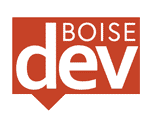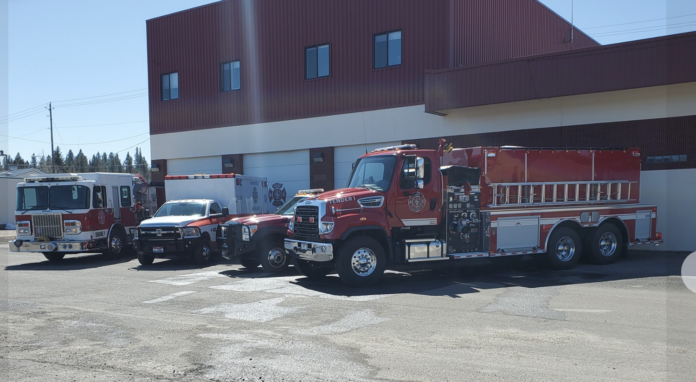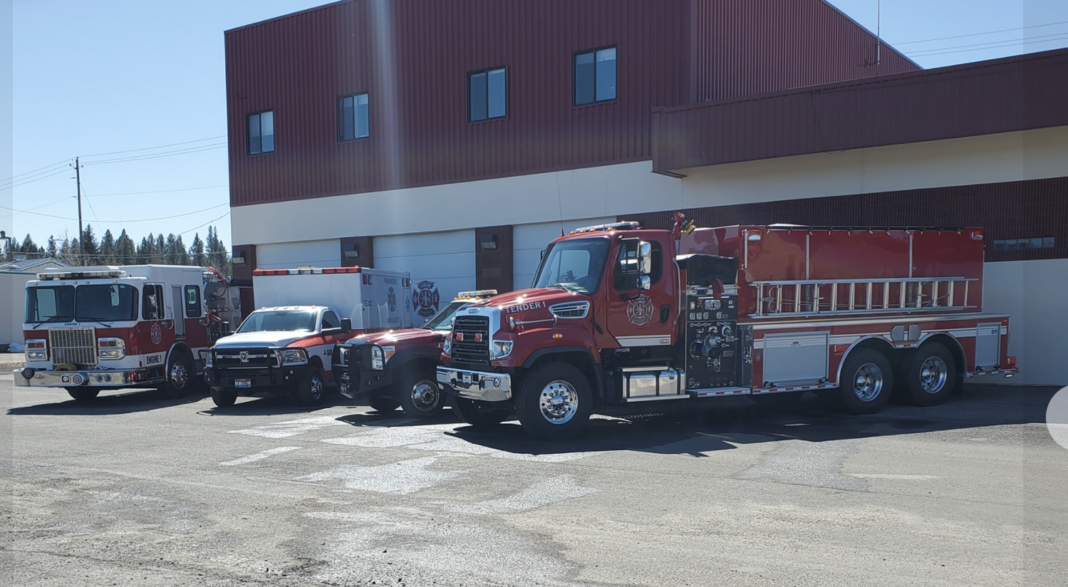Earlier this month, the Cascade Fire Department shared a story that detailed a medical call that sent a crew to Yellow Pine, a town about two and a half hours away.
A heavy snowstorm made the drive even longer. For seven and a half hours, the department’s only ambulance was out on a call, unavailable if another situation popped up.
Situations like this are increasingly common in Valley County, with what Cascade Fire Chief Steve Hull calls a “shortfall” in EMS funding.
For approximately the last two decades, the county commissioners have contracted with the three fire districts in McCall, Cascade, and Donnelly to run EMS transport services.
McCall Fire Chief Garrett de Jong said historically, the fire districts and ambulance systems operated using volunteers. But over the last ten years or so, the model has changed – with a combination of volunteers and paid workers.
De Jong said the reason for the change is “multifaceted,” but it can mainly be attributed to the increase in dispatch calls in the mid-2000s. As more paid staff were added, the number of volunteers declined.
“The decline in volunteerism is a national fire service issue driven by economics, values, community engagement, and other factors,” he said. “Valley County is somewhat of an anomaly too, where our full-time resident population is small in comparison to the demand for services, so we don’t have a large pool of people to draw from. If our full-time population was more aligned with demand, I think we would have more volunteer participation.”
The EMS district, which doles out tax dollars for the operations, was designed for the volunteer model. The tax levy currently contributes about $1.2 million annually, which is split between the three districts – each getting about $418,755 a year.
A small portion of the funds are kept for ambulance reserve. The reserve funds go to help buy ambulances and equipment. Valley Co. Commissioner Elting Hasbrouck said the fund isn’t significant, with about $70,000 in the account.
“It was really based on a funding mechanism that sustained a volunteer model,” de Jong said. “It wasn’t really intended to staff three ambulances 24/7. And that levy rate was set in like 2008. And so we’re just at a point where there isn’t enough money to pay for the services that are being provided.”
The districts collect additional tax dollars earmarked for firefighting – and some from fees, like propane inspections. But de Jong said the districts use fire funding to subsidize EMS.
“Each of the fire districts subsidizes that staffing model for the ambulances,” he said. “We’ve just been trying to work with the county commissioners to get enough funding to pay for the staffing model.”
Hasbrouck said most of the dispatch calls coming into the fire station are for EMS, but most funding goes to fire.
“If you look at their run calls, 75% to 80% of their runs as a fire station are for EMS and the other 20% or 25% is for actual fire or alarms, that kind of stuff. So most of the work is on the EMS side, but most of the funding is on the fire-side.”
High costs with limited funding
Funding for EMS comes primarily from the county’s taxing district and transportation revenue, though de Jong said there is not enough transport in Valley County for this to make a difference.
Transportation revenue is money collected from patients’ insurance or out of pocket when transportation to a hospital is required.
Without donors like you, this story would not exist.
Make a donation of any size here
He said a model that would both recruit and retain employees would have to pay about $30 an hour plus benefits and overtime pay. To staff and equip one ambulance, it costs about $1.1 million, and collectively the EMS taxing district brings in $1.2 million yearly. The revenue covers just a single ambulance.
“In Valley County, we would have to run about, I’d say 7,500 transports a year to capture enough revenue to pay for the staffing model,” he said. “Right now, collectively, between all three districts, we bring in about $330,000 in transport revenue. Each district gets just about $418,000 to provide EMS service. Just to pay two people 24 hours a day, seven days a week, 365 days a year at a competitive rate, you’re north of $500,000 just in wages.”
De Jong said the “primary concern,” especially in McCall, is overlap and duplicate calls.
“We’re getting into this predicament, especially when Valley County’s busy on peak weekends, Winter Carnival, or when the ski resorts are really busy where we’re having duplicate calls and overlap calls,” he said. “That’s the primary concern in McCall, especially in the summer months, June, July, and August.”
He said that high overlap percentages are an “indicator” that another unit needs to be added.
“We have a high overlap percentage, and our unit hour utilization metric on our first out ambulance is committed about 25% of the time, which in EMS, that’s an indicator that it’s time to start thinking about an additional unit for those time periods,” de Jong said.
He said all three districts put public safety first and will “bend over backward” to ensure they are handling all 911 calls – but he added that the time is now to fix this problem before it gets worse.
“I think our ask is more proactive than reactive and like we need to fix this,” de Jong said. “So, in a year, two years, five years down the road, we’re not just trying to put band-aids on a model that’s not gonna work long term.”
Levy and wages
All three districts use fire district funds to provide EMS services, but Cascade and Donnelly pay lower rates to employees than McCall. De Jong said a high turnover rate in McCall from 2016 to 2020 led to pay increases in that district. He said due to a lack of funding, Cascade and Donnelly are not able to pay competitive wages. Because of this they have long struggled to recruit paramedics, firefighters, and EMT firefighters.
“McCall turned over ten of twelve full-time employees, with most of them taking jobs in the Treasure Valley,” de Jong said. “The board of fire commissioners really prioritized getting pay rates to be more comparable with the departments with whom we compete for employees with. Not that Cascade and Donnelly don’t do that or want to, but McCall had more budget capacity with increases in new construction values plus the three percent increase each budget year to increase base pay rates.”
In 2023 the average hourly rate for a firefighter/paramedic in McCall is $33.09, Cascade is $17.84, and Donnelly is $19.50. For firefighters/EMTs in McCall, the average hourly pay is $28.88, Cascade is $16.19, and Donnelly is $16.50.
Last November, during the election, Cascade went to the voters to ask for an increase in the levy rate. The levy would have increased property taxes, and it failed.
The Valley County Elections Department’s election results showed 582 people voting against the levy and 509 voting in favor. A supermajority of 66.7% would have been needed for the measure to pass.
“It’s kind of two-fold in Cascade because the other districts have a little more fire district money where they can add to the coffers to increase wages and hire additional people,” Hull said. “Right now, we don’t have enough money on either side by fire funds or in EMS funds to staff either one sufficiently. That’s why we need the fire levy. If we can get money from the county to fully staff the ambulance and I can get a levy override, then that would provide staffing for the fire -side. But right now, we’re just kind of half on each side.”
Hull said the levy would be back on the ballot on May 16.
The Cascade Rural Fire Protection District is down one paramedic/firefighter staffer right now, and Hull added volunteer numbers are “pretty slim.” The department has about three to four active volunteers.
“This has been, I related back to 20 years ago when the sawmill closed down. That’s kind of been a trickle-down effect through the years. And 2008 is when the Cascade City Fire Department and Cascade Rural Fire Department combined because of a shortage of volunteers and it slowly declined from there,” Hull said.
Hull said he is “pretty concerned” about his staff and the public with the limited funding and staffing shortages.
“There’s a huge safety concern for me and my staff when we’re doing stuff with such minimum staffing,” Hull said. “And there’s a concern for the public as well when we’re out on an EMS call. For instance, last weekend, the two on-duty staffing went to Yellow Pine on a medical call, and that was seven and a half hour turnaround time. There was little to no coverage and Cascade for another call out. So it’s pretty concerning.”
Filling positions in Donnelly
Juan Bonilla, the Fire Chief for the Donnelly Rural Fire Protection District, spoke about how they have had two paramedic positions opened at the department for almost a year. Bonilla said the department didn’t have a single application to get those two positions filled.
“There’s a whole gamut of reasons. One is it is extremely difficult to live up here because of the cost of living. Two is if you live in the valley, it’s a long commute to come up,” Bonilla said. “We’ve had a few people that have tried in the past to work from the valley and come up, and it’s extremely difficult, especially in the wintertime. We have had struggles with that. We’ve brought it to the attention to the commissioners of the shortfall of personnel and just maintaining our current status.”
He said they want to maintain three people per shift in a firefighter, EMT, and medic but sometimes “fell short.” The three-per-shift rule was decided because that is what Donnelly’s budget can handle.
“If we have two runs at the same time, which we’re seeing a lot more …We don’t have the staffing for multiple runs at a time,” Bonilla said.” For instance, already three times this year we had five runs relatively at the same time or within one right after the other. We have a crew that’s out for anywhere from seven and a half to eight hours with one medic doing all those runs for that longer period.”
Bonilla continued saying that the three-staff rule gets them by, but the department will need more personnel and volunteers to handle multiple runs.
“…Three is like enough to get by,” he said. “But eventually, we’re going to have to move into more personnel and the use of volunteers to make sure we have back coverage so that we can maintain those multiple runs at a time.”
Bonilla said for Donnelly, this trend started a little before the COVID-19 pandemic, but it ramped up as the pandemic began impacting Idaho.
“We really have minimum staffing, so if you have one or two people who get COVID and have to be out for two weeks, which we’re still subject to right now, that’s pretty detrimental when you’re already short two people or more,” he said. “How do we capture, how do we backfill that person who’s not here? Or if we have someone who gets hurt or even just trying to take time off.”
Commission response
Hasbrouck said the commissioners held a few closed meetings about EMS funding and recently held a workshop with representatives from the fire districts. The hours-long workshop discussed items like potential one-time emergency funds and creating a new taxing district. This was just a discussion – no decisions were made. The advisory council will soon meet to further discuss what needs to happen to alleviate the EMS stress.
The districts were also tasked with working with the advisory council to update their operations and the contract over the next few months.
“We’re going to work through this. We are going to find some stability,” Commissioner Sherry Maupin said during the workshop. “I just wished I would have paid a little more attention because honestly, we each take our buckets and our buckets are pretty full right now. And I should have prioritized you guys differently. For that, I would apologize.”
Hasbrouck said the current model has worked well for most of the years but is struggling with growth happening
“Now we’re getting so many more people up here and more runs and more calls that we’ve got to be looking at providing more personnel and probably more staffing towards the EMS side of it,” Hasbrouck said.
Hasbrouck said in order to put both fire and EMS under one levy, the system would have to be canceled entirely. This is something that he said has not been discussed a lot because of the complicated process that would result in a vote that would require a two-thirds majority to pass.
“I don’t know when, 25 or 30 years from now when we have a lot more population, the county would be wise to think about separating those two districts into completely different groups,” he said “…I think we’re a long ways away from that, we just don’t have the demand or the population yet to split them up,” he said.
Some ideas that have been workshopped to mitigate this over the years included turning the basic EMT level service into more of a paramedic ambulance service.
“Paramedics can go out and do actual medications and actually help somebody at home. Maybe it’s somebody that’s out of balance or their insulin or something like that, and not have to transport to the hospitals and save everybody money all the way around,” Hasbrouck said.
He called “the goal” to transfer from EMT to paramedics.
“That’s kind of been the goal is eventually transformed from an EMT level to paramedic level,” Hasbrouck said. “Of course, the ultimate would be to have nurses available in the ambulance then they could do a lot more treatment at home and they’ll (not) have to transport to hospitals and save everybody money. That’s a pretty spendy ordeal to convert to nursing, but that’s a possibility down the road.”
Hasbrouck said that over his ten years as a county commissioner, he has seen funding and staffing issues across several departments since the county started to move to a more heavily populated area. The county has had to make adjustments over the year to handle these demands. Now it will need to pivot and make changes to fix the EMS stress.
“You could say this year it kind of came to push to shove, so to speak, because we’ve got to do something. I’m not sure it’s going to be an override,” he said. “We’re looking at how the fire districts are managing the EMS side of it and where some of those funds are going. Are they getting full compensation for their ambulance runs? And there are some things that we really need to kind of nail down before we start discussing increasing that levy rate.”
Hasbrouck said any change would take a public vote.
“… If we do, it’s not going to be for very much money but trying to position it so it will it’ll last 10-15 years into the future. It will be enough for them to grow those departments as demand increases on them,” he said.






